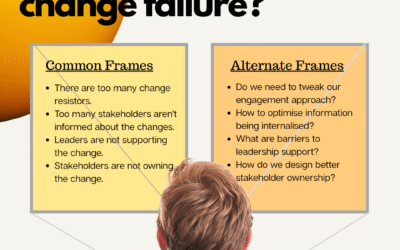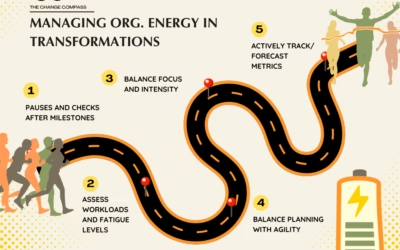Change management is a broad and diverse discipline with many facets. Just like other essential business domains such as Finance, Marketing, Human Resources, or Management, it encompasses a variety of sub-components. In Finance, for instance, there are sub-disciplines like accounting, tax, budgeting, and investment. Similarly, Human Resources boasts sub-disciplines like employee relations, remuneration, organizational development, business partnering, and learning and development.
Within the vast landscape of change management, various sub-disciplines unfold, each playing a crucial role in orchestrating successful transformations. These include change leadership, learning and development, change impact assessment, organizational design, communications, and change portfolio management. Furthermore, multiple functions across the organizational spectrum claim proficiency in change management, including Human Resources, Project Management, Strategy, and Operations Management.
Navigating this complexity requires a keen understanding of the interconnected nature of these sub-disciplines and the functions that contribute to change management. It’s akin to the intricate workings of Finance, Marketing, and Human Resources, where each component plays a vital role in the overall success of the discipline.
So, where do we begin in this expansive landscape? Let’s unveil the secrets to understanding the core of change management, starting with the often-overlooked, yet crucial, aspect of change impact. To delve deeper into this topic, access our infographic ‘Why lots of functions think they are all experts in managing change’.
Change impact
With so many components to grasp, where does one start in the expansive landscape of change management? And which component holds greater significance? While it’s tempting to label all components as important depending on the nature and context of the change, effective change management begins with a crystal-clear understanding of what is changing. To achieve this understanding, one must unravel the intricate web of change impact on various stakeholder groups, both internal and external to the organization. It is only after a deep understanding of the impact that planning for effective change management can take place.
In many instances, generic change approaches such as training and communications are employed without a detailed understanding of the nature of the change’s impact on stakeholders. The result? Change interventions that miss the mark, leading to resistance and a lack of support.
But how do we gauge this elusive concept of change ‘impact’? How do we understand change ‘impact’? There are many ways to do this.

1. Perception of the change
How does the impacted stakeholder group perceive the change’s impact on them? For example, if implementing a new system in an environment where users are comfortable with the existing one, the perception may be one of skepticism and negativity. Imagine introducing a new project management tool to a team accustomed to their existing system. If the current tool meets their needs seamlessly, the perception of the new system may be met with skepticism, especially if the ‘why’ behind the change isn’t effectively communicated.
The perception of the change is about the mindsets, attitudes, and expectations of people. These are not easily quantifiable and will require a deep understanding of that particular stakeholder group and the history of how they have transitioned through different changes.
The perception of the change can also be positive or negative. Positive perceptions of change could be the result of a perception or expectation of benefit, for example, the system may be easier to use, saves time, or accomplish significant tasks that are not possible with the existing system. Negative perception could result if the benefit case is not clear or, worse, perceived to be adding more time, more complexity, and providing less value.
Typical ways to understand the perception of stakeholders may involve surveys, interviews, and focus groups.

2. Severity of impact
Another dimension crucial in understanding change is the severity of its impact. Does the change demand significant investment and resources, akin to a major restructuring exercise? Or is the impact more modest, involving minor process tweaks and requiring only email notifications for those affected?
Measuring the severity of impact is often done using a Likert scale, with 1 denoting a small impact, 3 indicating a medium impact, and 5 signifying a very high impact.
It’s important to note that when employing a scale to assess change impact, a 5-point scale is recommended over a 10-point or 3-point scale. A 10-point scale might be too intricate for individuals to navigate, leading to challenges in distinguishing between, for instance, 6/10 and 7/10, where the material difference may be minimal. Conversely, a 3-point scale tends to oversimplify the analysis, as organizations typically contend with multiple changes, and categorizing all impacts into three broad categories may lack the necessary granularity to differentiate impact levels meaningfully.

3. Capacity of impact
Another crucial aspect of understanding change is assessing how it impacts the capacity of stakeholders to digest and transition through the change. Consider, for instance, the effort and activities required for managers of a business unit to be sufficiently briefed about a new system, enabling them to guide their teams through the process. What are the learning requirements, and what support is necessary?
For changes that are more complex, and demanding significant effort and involvement in the change process, it’s essential to identify these activities and evaluate their impact on the stakeholder group. Common change and transition activities influencing stakeholder capacity include:
- Town halls or briefing sessions
- Workshops and focus groups
- Involvement of subject-matter-experts
- Watching videos or reading emails about the initiative
- Team meetings to discuss the change
- Learning and development sessions
- Practice and gradual familiarity required
- Providing feedback about the change
- Attending any celebration or other events related to the initiative
Additionally, assessing the capacity of impacted stakeholders involves considering what else is happening during the change implementation period. Are there other changes or notable work tasks occurring concurrently? For example, is the change happening during a peak customer period or a major annual work cycle, such as the end of the financial year or audit? Understanding these contextual factors is crucial, as they can significantly impact the capacity of stakeholders.
In large organizations, where multiple changes are often underway simultaneously, navigating these capacity and bandwidth challenges is a skill in itself. Anticipating these challenges ahead of time and planning strategically is key. Explore our suite of articles on change portfolio management to gain insights into effectively managing multiple changes.

4. Time Impact
Considering the impact of change on stakeholder capacity extends to the element of time. Every aspect of change, from shifts in mindset to learning a new system, digesting emails and information packs, attending sessions and meetings, to practicing how to operate the new system, contributes to the temporal dimension of change impact.
Quantifying the time impact of various change aspects on different stakeholder groups allows for estimating the time ranges of impact. This quantification is especially valuable for teams that are highly time-sensitive, such as call centre teams or Finance teams during month-end or year-end periods, when they are deeply engaged in consolidating finances. Similarly, teams like Customer Complaints and Resolutions may experience heightened activity during end-of-year periods with increased customer volumes.
How do we put these into use?
How do we translate these insights into action? Change impact assessment is the critical process of evaluating the nature of change impacts on various stakeholder groups. By utilizing the methods outlined above to assess the impact of change, the change impact assessment generates a detailed set of information from which we can formulate the change approach. It is only after understanding the ‘what’ of the change that we can design the ‘how’ to transition stakeholders through the change.
The completed change impact assessment should be socialized and verified with those impacted. Without this verification process, there’s a risk that those affected may not agree with the captured change impacts, or there could be other impacts missed in the assessment.
At The Change Compass, we offer a cloud-based tool where organizations can input and visualize change impact information. By visualizing the data, we can assess risks and opportunities, including:
- Identifying groups that may need additional support due to the complexity or volume of the change
- Comparing different stakeholder groups to determine the most critical to the initiative’s success and the extent of their capacity impact, especially in terms of time
- Plotting change saturation points for different parts of the business, assessing the extent to which changes exceed these points. Based on this assessment, we determine risk mitigation strategies such as re-prioritization, providing additional resources, or adjusting the change implementation timeline
- Evaluating the extent to which impacts (across initiatives) on different parts of the business align with strategic goals. Are the largest impacts on parts of the business as expected according to the strategy? Is the organization’s implementation more focused on operational efficiency or growth, and does this align with the strategic intent?
In conclusion, understanding the core of change management requires a nuanced exploration of change impact, encompassing perception, severity, capacity, and time. By delving into these facets, organizations can chart a path to successful change, avoiding generic approaches that lead to resistance. The Change Compass provides the tools to unlock the full potential of change, ensuring that initiatives align with strategic goals and receive the support they need.
Ready to Transform Your Change Management? Book a Weekly Demo with The Change Compass and Unlock the Secrets of Successful Change!






